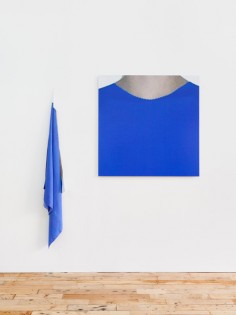anna sophie berger

source: artforum
Ruins can be preserved, or they can offer debris from which to build. It is with such wreckage that Vienna-based artist and fashion designer Anna-Sophie Berger creates work: Her practice is not fashion or art but a bricolage built upon collisions of the two—a product of a time when these industries seek to establish market-driven “synergy” but remain discrete.
.
.
.
.
.
.
.
source: frieze-magazinde
Medium (Green), 2014, digital print on Dibond with performer at JTT, New York; all images courtesy: the artist & JTT, New York
The artist Anna-Sophie Berger, who studied fashion design at the University of Applied Arts in Vienna, once suggested to me that artists, curators and dealers might feel an attraction to fashion because it harbours – in its overt, uncomplicated cop to commercialism – a surprising brand of authenticity. Fashion is refreshing in its conspicuous relationship to money and luxury, and its culture of recycling and disposal. It is, maybe, exactly what it is: design, product, advertising, sales.
Berger is an artist who primarily exhibits works of fashion. Although her pivot from fashion to art contains a certain insouciance towards distinctions between the two, Berger uses both to question differing modes of production, distribution and value-attribution, all of which are threads she carries throughout her artworks. Her works lend themselves to transposition not least because her garments are the result of a stripping down of things to their elemental units: works such as Square Window Tunic (2011) comprise hard edges and grid patterns. The works’ aesthetic finds a relative in Minimalist sculpture – Berger’s could be a scarf (2014) recalls Robert Morris’ series of heavy felt sculptures. But it’s the bold shapes and rich colours of Franz Erhard Walther’s fabric pieces that seem to have the strongest connection with Berger’s pieces, given Walther and Berger’s shared interest in the behaviour of the art object, its mobility and its activation by the body.
In 2013, Berger produced a series of leather slippers in bold, all-over colour with the shoe size printed across both feet. Each piece’s title repeats the size of the shoe: 39, 40, 41. Shown at HHDM in Vienna, Clearing in Brussels (both 2013), Tanya Leighton in Berlin and Off Vendome in Dusseldorf in 2014, the pieces were often tucked in a corner or next to the wall, like traces of a bedroom scene. A silk, grid-patterned dress from Berger’s collection M-M2 (2011) was sold during the group show Snout to Tail at JTT, New York, in 2013. Berger tells me it was purchased by a downtown dealer, subsequently fashion blogged, and ended up stained after a night of post-art fair partying. Berger likes this cross-contextual potential in her works.
For her solo show KE-17 JIGSAW KE-03 LARGE PINKING KE-24 SCALLOP KE-16 POSTAL at JTT earlier this year, Berger exhibited four garments in four colours – red, yellow, blue and green – as well as photographs of the same, mounted on Dibond and printed on silk. The clothing played the role of prototype: a skirt shaped like a tracing pattern of a skirt. Despite being handmade by Berger, the pieces have the intentional sleekness of something mechanically produced. For the opening, four performers wore the pieces for a version of Berger’s performance series Tell Me What To Do (2013–ongoing), moving through the gallery. Alongside the straightforward, almost stock forms of the physical works, Berger addresses the specificity that material and object have in their relationship to corporeality. The most common distribution of clothes, after all, happens via the bodies that wear them. Tell Me What To Do originated during a stint as a commercial photographer: Berger made an audio recording of herself giving posing directions and played the tape back for models during shoots. She noticed a surprising vulnerability emerge in the distance between direction and execution. She translated this interaction into performances, in which Berger gives basic physical directions to a varying number of participants. In more recent iterations it’s been a pairing, with Berger and a performer exchanging roles throughout. In the dry reduction of interchange to command – ‘say my name, stand up, clap your hands, say my name’ – a delicacy emerges through the vulnerability that Berger first noticed with her models. The result is a kind of procedural intimacy, in which the directness of the form encourages the specifics of interpersonal experience to emerge.
In Tattoo (2014), a collection of temporary tattoos exhibited this September at Steve Turner Contemporary in Los Angeles, Berger approaches a nexus of production, affect, branding and bodies. The tattoos display a brand name that Berger found on the tag of a pair of dollar store underwear. The brand name exists without a brand identity – cachet-less, Made In China, one blip in the incomprehensibly complex chains that make up the consumer landscape and what has been called the ‘sweatshop sublime’ by author and academic Bruce Robbins. Just feel, says the label. It’s a strange directive, disgusting and gentle, drab and evocative. Berger returns the untethered brand to the presumed superabundance of its origins, producing tattoo versions of the label at the absurd volume of 5,000 editions. The result acts as both diffusion and trace of specific experience – the weight of mass-produced goods refracted through the personal and intimate.
It’s fitting when Berger says to me that a piece of hers works best when it reads simultaneously as warm and cold. Warm/cold, mass/specific, procedural/intimate, her practice – casually traversing contexts – seems like a performance of ambivalence. Berger initially gained attention in 2013 with an ongoing series of cheaply produced black T-shirts with the words ‘FASHION IS FAST’ in white sans-serif font above the year the shirts were produced. The printed year will be updated annually, nullifying the previous cycle and announcing the project’s continued timeliness. It’s true: fashion is fast. Art is fast too.

